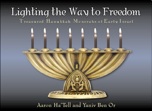excerpt: Chapter 3 Hanukkiot that Light the Way –These Lights are Sacred
(Almost) everything else you ever wanted to know about the
treasured menorahs of early Israel
...A growing and vital secular community encourages a more liberal interpretation of
the Second Commandment, and human figures appear more often than in Diaspora
hanukkiot. While women and children are also depicted, masculine motifs and bold
designs often assert the ‘new Jew.’ Other figures now include usually heroic,
but sometimes whimsical, depictions of contemporary and ancient man and popular icons.
Esthetic license, such as various placements of the Shamash or use of multiple levels for
the candles, sometimes even conflict with traditional religious conventions and practices.
Some hanukkiot are made in traditional Diaspora candelabrum or bench styles or their
symmetrical contemporary versions. Some are variations on specific editions of
contemporary or classic European masters. In others, these basic designs are elaborated
and new formats added, such as Aladdin lamps (based on ancient oil lamps,) hybrids,
asymmetric and free-forms, and musical and electric hanukkiot. Others portray sketches
or even paintings, reminding us that hanukkiot are works of art. Traditional, Bezalel, Art
Nouveau, Art Deco, Eames, and other design elements are pure or blended. Images are
executed in highly sculpted three-dimensions, bas relief, and detailed metal craft and
grillwork, or are just painted. Large and miniature or oil and candle versions often come
in pairs or families.
Added to traditional materials and techniques are modern materials like steel or
aluminum, or Timnah copper and turquoise stones, olive-wood, glass, iron, stone,
ceramics, pewter, and other indigenous or readily available inexpensive materials. Modern
techniques incorporate the use of machines, welding, etc. Surface finishes and other
variations reflect traditional and modern metal finishing techniques, and references
to ancient techniques in painted or enameled faux design, or actual small tile or stone
mosaics, color, and a symmetry appear. Polished brass, painted, baked enamel, lacquered,
or verdigris (1) versions or combinations can be seen of the same design...
Endnotes
1. Founder, owner, and chief designer of Pal-Bell Maurice Ascalon brought from Europe a technique of applying hot chemicals to the surface of copper to produce a greenish finish known as verdigris. While the process had been used in Europe for larger sculptures, Ascalon was one of the first to use it widely in smaller metal craft. (Carl Sorensen of Philadelphia had made small Arts and Crafts verdigris pieces ca. 1900.) The appearance and color became popular and widely imitated, but Pal-Bell’s had been the best. As it ages, it often wears off.
Its use ceased after the early 1960s because it was not safe for workmen. The greenish
color became identified with Israeliana, and used in painted lacquered or baked versions
since, sometimes referred to as ‘faux verdigris.’ In this book, we refer to either the authentic or later painted versions as ‘verdigris.’

Copyright © 2010 Aaron Ha’Tell. All rights reserved.
Website Designed by Jessica Schwarz
The struggle for freedom is always!
Hundreds of beautiful photos tell the story of the rebirth of a free people...


